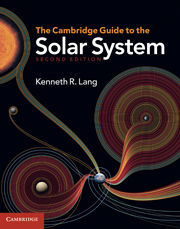Book contents
- Frontmatter
- Contents
- List of focus elements
- List of tables
- Preface to the second edition
- Preface to the first edition
- Principal units
- Part 1 Changing views and fundamental concepts
- 1 Evolving perspectives: a historical prologue
- 2 The new close-up view from space
- 3 Atmospheres, magnetospheres and the solar wind
- Part 2 The inner solar system: rocky worlds
- Part 3 The giant planets, their satellites and their rings: worlds of liquid, ice and gas
- Part 4 Remnants of creation: small worlds in the solar system
- Part 5 Origin of the solar system and extrasolar planets
- Author index
- Subject index
2 - The new close-up view from space
from Part 1 - Changing views and fundamental concepts
Published online by Cambridge University Press: 05 August 2011
- Frontmatter
- Contents
- List of focus elements
- List of tables
- Preface to the second edition
- Preface to the first edition
- Principal units
- Part 1 Changing views and fundamental concepts
- 1 Evolving perspectives: a historical prologue
- 2 The new close-up view from space
- 3 Atmospheres, magnetospheres and the solar wind
- Part 2 The inner solar system: rocky worlds
- Part 3 The giant planets, their satellites and their rings: worlds of liquid, ice and gas
- Part 4 Remnants of creation: small worlds in the solar system
- Part 5 Origin of the solar system and extrasolar planets
- Author index
- Subject index
Summary
• Close examination of the planets and moons began when spacecraft flew past them, providing an initial reconnaissance. Orbiting spacecraft that mapped out the global terrain of the Earth's Moon, Venus and Mars, as well as the realms of Jupiter and Saturn, followed this. Probes have been parachuted down into the atmospheres of Jupiter, Titan and Venus, and landers and rovers have been sent to the surfaces of the Moon and Mars.
• The space-age investigation of the solar system began in a cold-war competition between the Soviet Union, which launched the first artificial satellite, and the United States, which won the race to the Moon.
• The Voyager 1 and 2 flyby spacecraft transformed our understanding of the four giant planets, Jupiter, Saturn, Uranus and Neptune, and revealed fascinating, unexpected aspects of their moons and rings.
• The Giotto spacecraft was the first to provide a close-up view of a comet, showing that its nucleus is a black, city-sized chunk of water ice and dust that emits sunward jets of water when passing near the Sun.
• Orbiting spacecraft have greatly increased the time for study of the planets and moons, revealing ancient water flow on Mars, vast outpourings of lava on Venus, Jupiter's volcanic moon Io, and an ice-covered ocean on its satellite Europa, and Saturn's marvelous rings, water-spewing satellite Enceladus, and haze-shrouded moon Titan.
• Three rovers have explored the surface of Mars and provided evidence for water flow across its surface roughly 4.0 billion years ago. […]
- Type
- Chapter
- Information
- The Cambridge Guide to the Solar System , pp. 36 - 79Publisher: Cambridge University PressPrint publication year: 2011



